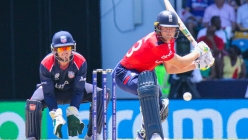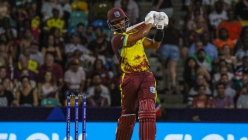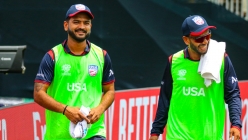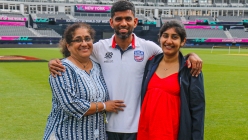Views
USA Cricket: 2019 CWC League Two UAE Tri-Series Tour Report Card Part 2 – Player Grades
2019 Dec 17 by DreamCricket USA
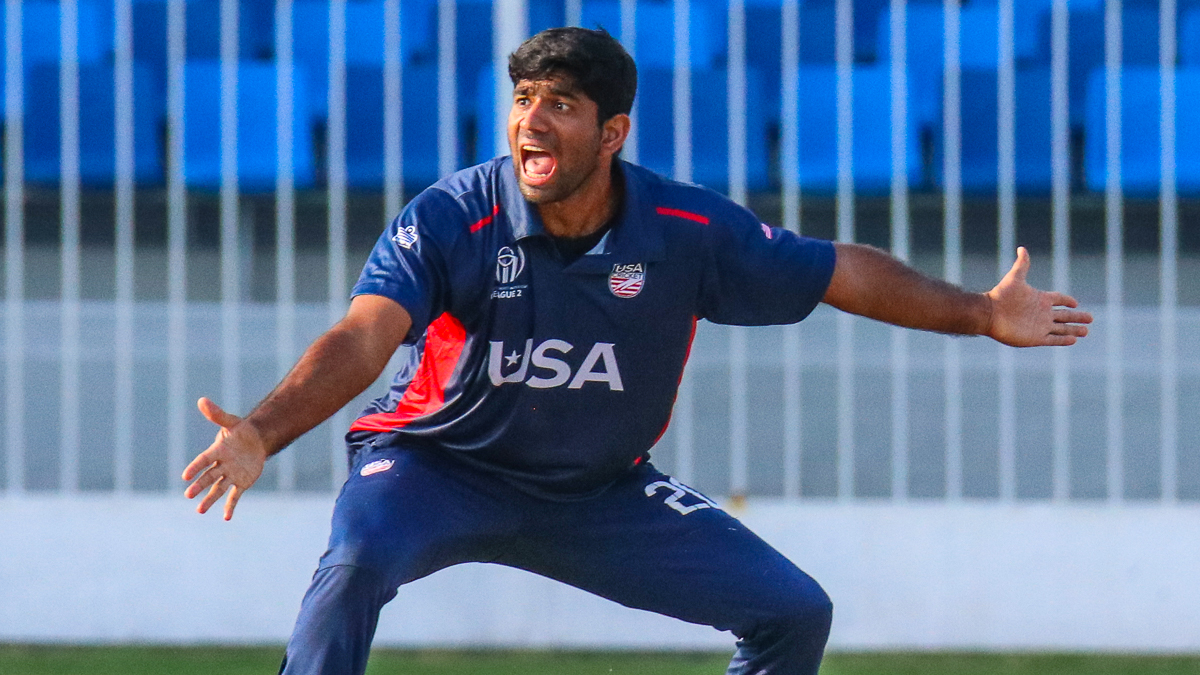
By Peter Della Penna (Twitter @PeterDellaPenna)Photo Credit: Peter Della Penna
In part two of DreamCricket's tour report card of the Cricket World Cup League Two tri-series in the UAE, each of USA's 14 players on tour are graded on their performances.
For those unfamiliar with how individual players have been graded in the past as part of Dreamcricket’s post-tournament report cards, each player is evaluated with regards to their specific role in the team on a match-by-match basis and not solely based on aggregate stats.
Players who excel under pressure and against higher quality opposition are graded more favorably. Overall chances given by a batsman, as well as overall chances created by a bowler, are taken into consideration regardless of total runs scored or wickets taken. Bonus marks are given for good fielding while a player can also be downgraded for weak fielding including dropped chances.
With those guidelines laid out, here are DreamCricket’s player grades for the 2019 tour of the UAE for a Cricket World Cup League Two tri-series against UAE and Scotland, where USA finished with a record of 3-1.
Xavier Marshall: B
The X-Man looked as good as he has since March when he was a run scoring machine on USA’s last tour of the UAE. Marshall ended with 115 runs in four innings at an average of 28.75 and one half-century, finishing as USA’s second-leading scorer on tour behind Aaron Jones. Marshall made scores of 34, 0, 31 and 50.
His first innings against UAE ended in controversial circumstances in Sharjah when he was given out obstructing the field despite not appearing to have done anything deliberate to get in the way of an attempted runout throw from square leg. Marshall was out for a golden duck to the first ball of the match against Scotland in Sharjah not offering a shot to Safyaan Sharif. In Dubai, he looked set for a century in both innings but was done in by a slower ball against UAE and then miscued a lofted drive upon going cold in the overs leading into his reaching a half-century. The disappointing part is that despite getting so many starts, Marshall never truly kicked on.
Marshall was a part of two of USA’s five 50-plus partnerships in the UAE and showed far more positive intent with his running between the wickets than he had in Trinidad a month earlier. As for his fielding, Marshall was sent off to field at fine leg and third man for the majority of the tour, having been a liability in more high traffic positions in USA’s past several tours. But rather than sulk about it, Marshall responded quite positively to his new assignment and was actually very dedicated to throwing his body around to save runs on the boundary. Meanwhile the strongest facet of his fielding, his throwing arm, was allowed to shine in a place where his other shortcomings are more easily disguised. He had no catches, but more importantly no drops on tour.
Overall, this tour was a very positive step back in the right direction for Marshall after an extended stretch of indifferent form that began in August. Teammates and fans should have confidence that he’ll make positive contributions next February in Nepal for USA’s next League Two tri-series.
Monank Patel: C
It was a Jekyll and Hyde tour for Monank, mostly the latter though. He finished with 90 runs in four innings at an average of 22.50. 82 of those runs came in a Man of the Match effort against Scotland at Sharjah when he was part of a 140-run stand with Aaron Jones. But he had three failures in his other innings, posting scores of 0, 8 and 0.
In the field, Monank also had an okay tour, contributing to two runouts and taking a catch behind the stumps filling in for an injured Akshay Homraj. However, he also spilled a chance with Josh Davey on 8 standing up to the stumps off Ian Holland on the final day that allowed Davey to make an unbeaten 26 in a Man of the Match effort. After being USA’s leading scorer in Trinidad, this tour was a mild step back for Monank but there are no obvious warning signs that should worry USA fans about him leading into 2020.
Steven Taylor: C-
USA’s vice-captain finished with 89 runs in four innings, fifth overall for USA on tour. Taylor made scores of 0, 17, 16, and 56. With the exception of his golden duck against UAE in which he was given lbw not offering a shot, Taylor’s innings were highlighted by a repetitive knack for throwing away a start.
Perhaps the most frustrating dismissal for USA observers to witness was his shot in the third match against UAE at ICC Academy in Dubai. After seven straight dot balls against Rohan Mustafa’s offspin, Taylor played a very casual lofted drive to long-on. It’s the kind of shot Taylor has played with zero consequences throughout his entire career for USA. He tried to atone for it on the last day making a half-century, but just like he did in his lone half-century in Trinidad, he threw it away with a loose shot cutting to Richie Berrington at backward point in an instance where he looked tired having grinded through 81 balls and 28 overs, close to two hours at the crease. He did not hit a single six during the tour, another worrying sign that his best days with the bat may be behind him.
With the ball, he contributed 2 for 33 in eight overs in the first match win over UAE, but only bowled one over the rest of the tour. Where Taylor really saved himself from getting a lower grade was his exceptional fielding. He was USA’s standout fielder on tour, taking two sensational catches at slip and backward point while his ground fielding was generally well above average when he was stationed elsewhere in the ring.
Taylor’s record at No. 3 continues to be below average. But his all-round attributes have kept him out of danger from being dropped.
Aaron Jones: A-
The middle order star followed up his worst tour for USA with one of his best, ending as the leading scorer for all batsmen in the tri-series with 215 runs at an average of 53.75 and two half-centuries. He made scores of 95, 74, 46 and 0 in his four innings.
Jones entered facing a hat-trick ball against UAE on day one and ended just one shot away from being USA’s first ever ODI centurion. Only a brilliant one-handed leaping catch at deep square leg by Waheed Ahmed denied him the feat. Against Scotland, his 74 was part of a 140-run stand with Monank Patel. It was Jones’ fifth century stand for USA in just his 27th innings, highlighting his penchant for building major partnerships for USA. For context, Steven Taylor has been a part of five 100-plus partnerships in 70 career innings.
His 46 against UAE at ICC Academy might not look special in isolation next to his two half-centuries, but it was the highest score in the match and once again he was also part of a 69-run partnership with Akshay Homraj for the fifth wicket, also the highest in the match to lift USA from a tricky position at 71 for 4. The only blemish was his six-ball duck on the last day against Scotland, a rare failure, which bumped him down from getting an A+. But he was involved in three of USA’s five 50-plus stands on tour.
In the field, Jones took a match-winning catch on day two against Scotland, charging forward from midwicket in the ring to pull off a diving effort to remove Calum MacLeod for 86. Once the reigning ICC Associate Player of the Year was dislodged, the last three wickets fell in the space of seven balls. At times, Jones can be sloppy in the field along the boundary and was guilty of a few misfields. Otherwise, he is generally a safe though not elite fielding presence.
On the whole, this tour confirmed that the form trough he experienced in Trinidad was a minor blip. Jones enters 2020 as USA’s best and most consistent batsman.
Ian Holland: B
Looking at the raw stats, Holland doesn’t appear to be an impact player. But ever since his last match in Trinidad he has been an unsung hero in this USA lineup with both bat and ball. As was the case against Guyana, Monank Patel was awarded Man of the Match against Scotland in Sharjah in a situation that appeared more stats based than a judgment made using eyes watching the context of his performance. Holland finished with 76 runs in four innings at an average of 19.00 and took five wickets at an average of 20.00.
He started with 0 for 9 in one over and a score of 19 off 35 balls before falling to a return catch to Ahmed Raza in a win over UAE. Against Scotland a day later, Holland scored 44 off 29 balls in a crucial surge to build upon the 140-run stand between Jones and Monank. He then took a superb catch at gully to dismiss Matthew Cross before a crucial momentum-shifting spell of 2 for 43 in eight overs. Scotland were cruising at 164 for 3 in the 35th over chasing USA’s 282, but Holland dismissed Richie Berrington for 34 and then George Munsey for 16 to bring USA back into the match.
Against UAE at Dubai, he was out for a low score of 5 but then was ruthless in wiping out the tail, flummoxing the UAE lower order with his slower balls, yorkers and other variations to claim 3 for 11 in four overs. He made another low score of 8 against Scotland in Dubai, but contributed an economical spell of 0 for 37 in 10 overs. He should have had Josh Davey caught behind for 8 but was dropped by Monank Patel, and Davey went on to make an unbeaten 26 in Scotland’s four-wicket win.
Aside from his crucial bowling and batting cameos, Holland is a brilliant fielder. Besides the fantastic gully catch he took to dismiss Cross in the second match, he took another low slip catch off Chirag Suri in the third match vs. UAE and claimed a far simpler return chance later for one of his three wickets. He only missed one chance, a fast edge at slip off Steven Taylor’s bowling when Rohan Mustafa was on 5. The ball went for a boundary but Mustafa was dismissed three balls later.
Holland is a shrewd operator with the ball and capable of some decisive innings with the bat in the last 10 overs. When available outside of his County commitments with Hampshire, he has rapidly turned into a vital asset.
Akshay Homraj: C+
It might shock people to hear that Homraj ended as USA’s third highest scorer in the UAE. He ended with 99 runs in four innings at 24.75. He got four starts – 14, 24, 34, 27 – but was never able to kick on to a big score after getting set.
However, Homraj was at times a steadying force acting as a bridge in the middle order to stretch innings out before a late push from elsewhere. He was a part of two of USA’s five 50-plus stands on tour, adding 69 with Aaron Jones to lift USA from a hole at 71 for 4 against UAE. He then added 56 with Nisarg Patel in USA’s last match against Scotland after they were struggling at 123 for 5 in the 30th over. A good case could be made that he should have kicked on to a bigger score on both occasions, but he didn’t exactly fall on his face either. If anything, he curbed his natural free-flowing strokeplay in an attempt to adapt to the situations for the benefit of the team.
Behind the stumps he was tidy though not spectacular. In all, he had seven dismissals and zero dropped chances. He had four dismissals in the first match against UAE in Sharjah, one against Scotland at the same venue before one more each in both matches at ICC Academy. However, he couldn’t stay on the field for the entirety of the final match, injuring his hand trying to save five wides from a Cameron Stevenson bouncer and left in the 16th over never to return. Durability was an issue with him in Trinidad and he did not ease those concerns in the UAE.
Homraj should be in the touring squad to Nepal in the new year. But if he goes another series without a half-century, it will test the patience of selectors looking for more runs from the wicketkeeper position.
Karima Gore: B-
The 21-year-old played an unsung role once again in clinching USA’s opening day chase against UAE. Entering with 38 runs needed and five wickets in hand, Gore struck an unbeaten 26 off 29 balls, including the winning boundary to ease USA’s nerves after a late flurry of wickets. He entered with 29 balls left the next day against Scotland and scored another unbeaten 8 off 12 balls this time around. It might not look flashy on paper but he once again batted intelligently to stretch out the innings through a late flurry of wickets in order to allow Saurabh Netravalkar to go wild on Alasdair Evans in the final over.
With the ball, Gore was somewhat quiet going wicketless in the two matches he played, though he maintained a respectable economy rate of 4.10 in the 10 overs he bowled across the two matches. He also had a chance put down off his bowling by Cameron Stevenson against Scotland when Michael Jones was on 36 before scoring a half-century. Gore looked close to a wicket on numerous occasions in that spell and saved plenty of runs fielding off his own bowling too.
Gore gave USA fans a serious fright when he injured his right hamstring chasing down a boundary from Jones in the win over Scotland. He left the field and a scan later showed a minor tear that resulted in him sitting out USA’s final two matches on tour. He should be healed in plenty of time for USA’s tour of Nepal and his first year in the national team has demonstrated he is a cornerstone player for the next decade.
Nisarg Patel: B-
The California allrounder continues to trend upward at a steady pace without banging down the door to put major pressure on the more established players in the squad. Coming into the XI for the injured Gore in USA’s last two matches, Nisarg totaled 78 runs in two innings to end with USA’s second-best average on tour behind Aaron Jones.
He scored a very mature 40 off 49 balls at No. 7 against UAE to ensure USA made it through to the final over and it served as the second highest score by either side in the match. He only struck one four in the knock before he was runout in the final over trying to steal a bye to get back on strike. The knock was in stark contrast to how he has batted in similar situations in the past, trying to attack too soon. Against Scotland, he was involved in a half-century stand with Akshay Homraj to lift USA up to a competitive total. But after being dropped twice, he failed to kick on and fell for 38 off 52 balls when USA desperately needed a late surge.
Nisarg has a slowly building reputation for claiming big scalps with the ball. He trapped Richie Berrington missing a sweep to end with figures of 1 for 41 in seven overs against Scotland, but he was not used against UAE with the ball.
If Nisarg was able to convert more of his starts, he’d be pushing to become a first-choice player in the starting XI. For the time being, he is a very solid reserve option in an instance such as this tour when a player like Gore goes down injured.
Cameron Stevenson: B+
In quick time, Stevenson has become an x-factor player for USA. Though he can be wild at times, it might best be described as being wild with a purpose because his pace at least plants a seed in the mind of the opposition batsmen that he possesses the extra yard or two of pace the rest of USA’s bowlers don’t have which hustles batsmen and leads to valuable wickets.
Stevenson ended the tour with nine wickets, second to Saurabh Netravalkar for USA, taking them at an average of 16.56. After returning 0 for 17 in five overs in USA’s opening day win over UAE, he took 3 for 43 against Scotland in what was arguably a match-winning spell. The wickets included an ominous looking Dylan Budge for 27 off 25 balls before he induced a false heave from Calum MacLeod on 86 for a backbreaking wicket that opened the door for Rusty Theron to wipe out the tail.
He was credited with 3 for 22 off seven overs vs. UAE but deserves an assist for roughing up Rohan Mustafa with a blow to the forearm that shook the left-hander up enough to the point where Netravalkar took his wicket in the very next over. In the final match against Scotland, he took 3 for 67. His ball to get Kyle Coetzer was a brutish short delivery that highlighted his ability to get top-class batsmen out with very accurate short-pitched plans of attack. However, he was also in some way a culprit for handing momentum back to Scotland when he leaked 18 runs in an over just after claiming Michael Jones for his second wicket and Scotland were never off course for the remainder of the chase.
With the bat, he had a run of failures in the first three games before coming through with another handy nugget against Scotland just like he had throughout the Super50 tour in November. He made an unbeaten 34 off 32 balls through very clever batting but was also extremely efficient running between the wickets, especially in the final over when he converted a pair of long twos into threes for Nosthush Kenjige.
In the field, Stevenson dropped one very easy chance off Karima Gore in Sharjah against Scotland when Michael Jones was on 36 but then took a far more difficult chance running around the boundary to claim a skier for Ian Holland in the third ODI of the tour against UAE at ICC Academy. He also dropped a very difficult return chance off Calum MacLeod on 56, who went on to make 86 in the first match against Scotland in Sharjah. He is generally a high-energy presence in the field both vocally and with his feet.
Stevenson looks like he has plenty of good years left in him as long as he stays fit. It’s hard not to see him being a first choice player for the foreseeable future.
Rusty Theron: C
The hardest player to grade on this tour, Theron wasn’t great but wasn’t terrible either. He had several flashes of brilliance but also one very costly death over in the final match against Scotland. Overall, he had four wickets at an average of 42.25.
Theron took figures of 1 for 46 in the first match against UAE, dismissing Basil Hameed who would later turn in a Man of the Match performance against Scotland in his fourth ODI of the series. Theron’s best match came on day two against Scotland when he claimed the prized scalp of Kyle Coetzer with the new ball before showing a ruthless killer instinct to wipe out the tail once Cameron Stevenson created an opening for him with the wicket of Calum MacLeod and Theron ended with figures of 3 for 46.
He had 0 for 31 in five overs against UAE on match day three, then ended with 0 for 46 in nine overs on the last day. That was a tale of two spells as he was absolutely brilliant with the new ball building pressure for Netravalkar but bowled a garbage over in the 48th that conceded 15 runs to Safyaan Sharif and Josh Davey when he repeatedly went too short and too wide with third man up in the ring.
With the bat, Theron did little. He scored 11 runs. In the field he was okay, taking one catch with no drops.
Theron looks like he coasts at times to preserve his body. But he also knows when to turn it on in important situations. He might only have two or three good years at best left in him but seems determined to make them count for USA.
Saurabh Netravalkar: A
The highest graded player on tour, Netravalkar was locked in like a Delta Force sniper in the UAE. He ended with 10 wickets, most for USA in the series, at an average of 10.80 and an economy rate of 2.91.
A measure of his unerring accuracy was the six maidens he bowled on tour. He started off with USA’s maiden ODI five-wicket haul against UAE, which included 4 for 2 in the space of seven balls to wipe out UAE’s tail and leave Muhammad Usman stranded on 59 with ten balls left unused, which wound up being quite crucial in USA’s three-wicket win.
He struck with the new ball against Scotland a day later to claim 1 for 34 in nine overs. Netravalkar was then named Man of the Match, having missed out to Aaron Jones on the day of his five-for vs. UAE, taking 3 for 11 in nine overs as part of a relentless new-ball spell that reduced UAE to 32 for 5 chasing USA’s seemingly below par total of 213. On the last day against Scotland, he took 1 for 31 in 9.5 overs.
With the bat, Netravalkar also provided a crucial contribution against Scotland in Sharjah. Coming in with 18 balls to go, he pushed singles with Karima Gore until the final over when he tore into Alasdair Evans for two fours and a six in his unbeaten 19 off 11 which proved significant in USA’s eventual 35-run win. He also batted maturely for scores of 12 and 7 in USA’s final two matches in Dubai.
In the field, Netravalkar was serviceable on this tour, taking a lobbed up return catch as well as one more at mid-on off Cameron Stevenson and dropped no chances. He is not the best along the ground but recognizes his deficiencies and puts himself in positions at fine leg, third man and mid-on that generally won’t harm the team.
Considering that Netravalkar got an F over the summer in Bermuda for his role in USA’s T20 World Cup Qualifying debacle, this performance was near flawless by comparison. USA fans will be hoping for more of the same in 2020.
Nosthush Kenjige: C+
USA’s leading statistical spinner on tour, Kenjige took three wickets at an average of 43.00 and an economy rate of 4.96 in 26 overs on tour. Those numbers pale in comparison to Scotland left-arm spinner Mark Watt, who took 7 for 75 in a pair of matches against USA in the UAE.
Kenjige’s overall numbers were below average, but he did contribute a couple of key wickets. It was Kenjige who removed Michael Jones for 52 with an outstanding return catch diving low to his left. Kenjige also bowled Basil Hameed for 38 in the rematch against UAE at ICC Academy, UAE’s top-scorer and last recognized batsman on the day who had propped up UAE after the new-ball burst from Netravalkar.
Kenjige gets significant bonus point upgrades though for his fielding. He was involved in two runouts, getting Darius D’Silva on a relay from backward point to the bowler’s end in the first day match at Sharjah, then ran out Calum MacLeod on the last day in Dubai from midwicket.
On the batting side, Kenjige extended his record of not outs with two more in USA’s last two matches, showing that he can always be relied upon to hold up an end as a No. 11.
Overall, Kenjige still appears to be battling to keep his place in the starting XI, something that is largely dependent on conditions. But he continues to be assured of his place in touring squads because he is an excellent fielder with an outstanding work ethic that rubs off for the better on virtually everyone in the squad.
Elmore Hutchinson: Incomplete
The 37-year-old never made it into the starting XI on tour, but was a positive influence as a substitute fielder on numerous occasions.
Timil Patel: Incomplete
The 36-year-old never made it into the starting XI on tour. He fielded as a substitute on a few occasions, serving adequately when needed.
ICYMI - Read Part 1 - Team Grades.
[Views expressed in this article are those of the author, who was present at all of the team's matches on tour in the UAE, and do not necessarily represent the views of DreamCricket management. If you have different views or opinions, we respect those views and urge you to provide your feedback, both positive and negative. Feel free to respond to the author via Twitter @PeterDellaPenna.]
